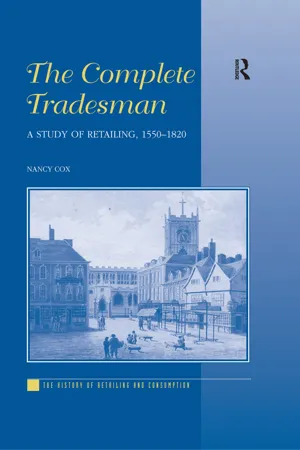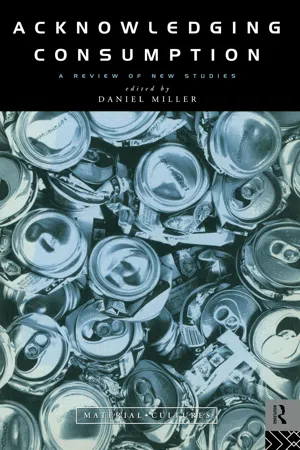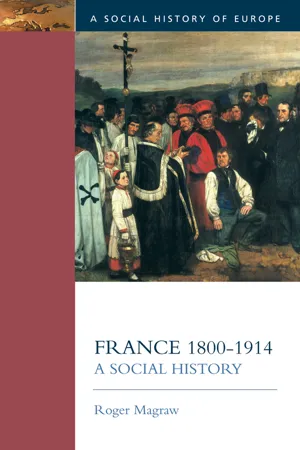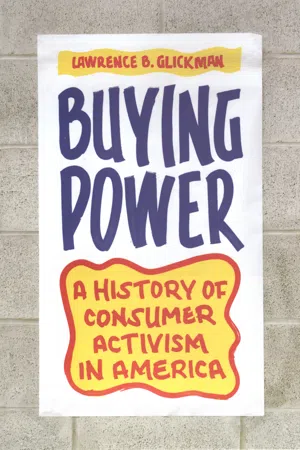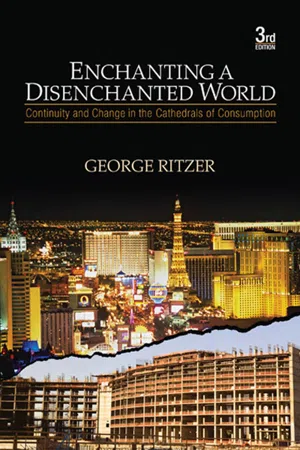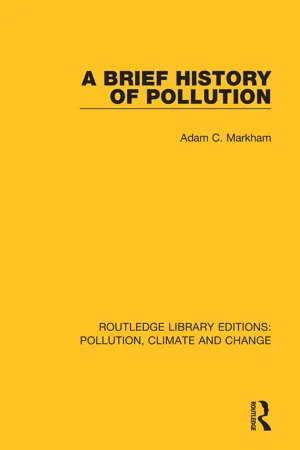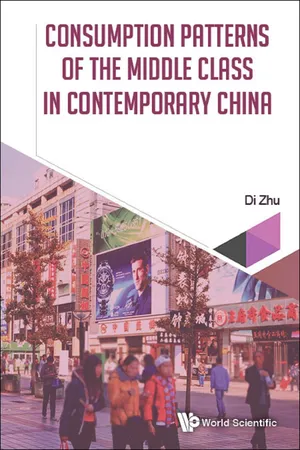History
Consumer Revolution
The Consumer Revolution refers to a period in history, particularly during the 18th century, when there was a significant increase in the consumption of goods and services by individuals. This was driven by factors such as rising incomes, urbanization, and the availability of a wider variety of products. The Consumer Revolution had far-reaching effects on society, economy, and culture.
Written by Perlego with AI-assistance
Related key terms
11 Key excerpts on "Consumer Revolution"
- eBook - ePub
The Complete Tradesman
A Study of Retailing, 1550–1820
- Nancy Cox(Author)
- 2016(Publication Date)
- Routledge(Publisher)
9 most attention has been devoted to economic and social change; until recently much less has been directed towards investigating the relationship between retailing and cultural change. The introduction of such concepts as 'Consumer Revolution' and 'consumerism' initiated a shift towards the cultural implications of retailing and it is to the development of ideas of Consumer Revolution that we now turn.Consumer Revolution
'Consumer Revolution' is a phrase that has suffered much from over use since its relatively recent introduction. It has spawned a number of definitions and applications and, with its underlying ideas, has provided a framework upon which scholars have built conflicting theories about economic, social and cultural change. The wider the chronological span to which the phrase has become attached, the more it becomes apparent that there is no agreement on precisely what the term means. Most scholars of modern economic and social history would assert that the only true Consumer Revolution occurred in the late nineteenth century and the early twentieth, when the urbanization and industrialization of the country produced a working class with opportunities not available to their forebears.10 To these historians, the Consumer Revolution is synonymous with mass production, mass marketing and mass consumption, and the Market is the key to that revolution. Attractive streets and gleaming shop windows encouraged avarice and day dreaming far beyond the immediate reach of many purses, while stores like Woolworths and Marks and Spencer allowed all but the destitute some share in the new world of luxury and its imitators. Defined like this it is impossible not to agree with this interpretation of the nature of Consumer Revolution.11However, another school of thought has argued that the seeds of change were sown in the eighteenth century if not even earlier.12 They see an increased variety of goods, some once imported as luxuries but now produced more cheaply at home, and a developing sophistication in marketing from a very primitive base. The evidence for the change is most easily observed, they would argue, in the home where raised standards of comfort, particularly for the middling sort of people, were matched by specialized room use, rising expenditure on the presentation of a public face to visitors and increased facilities for leisure. Just as the later period is typified by the threepenny and sixpenny stores, so this earlier age has its symbol of consumption - the new commodity of tea. Tea drinking was a new pleasure and not a replacement for other similar practices. By the beginning of the eighteenth century it was firmly associated with sugar, another commodity also new to most of the population. By the end of that century tea drinking had become not only an adjunct of polite conversation but also a popular drink providing comfort to the poor.13 - eBook - ePub
- Daniel Miller(Author)
- 2005(Publication Date)
- Routledge(Publisher)
5 CONSUMPTION WITHIN HISTORICAL STUDIES
Paul Glennie
IThe significance of consumption for history
INTRODUCTION AND BACKGROUND
Earlier this century, industrial and agricultural revolutions were being discovered almost everywhere that historians looked. Recently it has been Consumer Revolutions, at least among European and American historians (little literature has hitherto addressed other histories of consumption, though see Clunas 1991). Phrases like the birth of consumer society, emergent modern consumption, the rise of mass consumption, and the rise of mass market culture have been applied to the sixteenth and early seventeenth centuries (Thirsk 1978); Restoration England (Earle 1989: Shammas 1990; Weatherill 1988); the early eighteenth century (Eversley 1967); the Georgian period (Campbell 1987; McKendrick, Brewer and Plumb 1982; Williams 1987); the late nineteenth century (Fox and Lears 1983; Fraser 1981; Lee 1981); and between the two World Wars (Miller 1991). And, of course, each account raises questions about defining ‘consumer society’, and about consumption’s connections to wider economic and cultural changes.This proliferation reflects both continuous growth in Western consumption, and historians’ various definitions of ‘consumer society’. In addition, work on consumption is characterised by fragmentation, with very many local case-studies. Most general treatments of consumption either cover short periods and a single country, or take a long-run comparative view only for certain goods. The sheer variety of available sources (artefactual, documentary, visual, literary), and the divergent agendas of specialised research fields in different countries, exacerbate diversity and fragmentation. Different histories inform, and are informed by, highly divergent general analyses on consumption, and many historians distrust explicit theorising as a comparative and synthesising device. - eBook - ePub
France, 1800-1914
A Social History
- Roger Magraw(Author)
- 2014(Publication Date)
- Routledge(Publisher)
Chapter 8The birth of a consumer society?Introduction
Studies of the ‘industrial revolution’ once emphasised technological change and production. It is no accident that historians’ focus has now shifted towards consumption, for consumerism is central to the culture of our age. With the decline of clear ‘class’ identities built around work has come an emphasis on those constructed around consumer taste and lifestyles. Choice in the market-place, it is assumed, defines one’s true essence. I shop, therefore I am – and I am what I buy! ‘Trickle-down’ economics revitalised once fashionable, but briefly discredited, assumptions that élite consumption produced benefits for the poor. Insisting that expensive silk gowns should be worn at Court in the 1857 industrial recession, Empress Eugènie explained that ‘when those above are spending, there is no unemployment down below’. During the 1847 depression etiquette magazine Le Counseiller des Dames observed that ‘government, in the interests of the labouring population, wants celebration parties, gatherings of the fashionable set – for they are precious sources of work for all industries’ (Vanier 1960). Because our own ‘underclass’ allegedly dreams of Armani fashions and Porsches, the Industrial Revolution has been re-conceptualised as a consumer-driven process during which elite tastes in furniture, porcelain, fashion and colonial goods were aped by rising ‘middling classes’, then by the populace as servants coveted their employers’ cast-off fashions and workers emulated the servants (Fine and Leopold 1990). Certainly British workers developed a taste for cheap colonial goods such as tea and tobacco, and wore bright-coloured cotton clothing, though some remain unconvinced that a ‘bleak-age’ of worker immiseration can be reinvented as an era of popular consumerism on the strength of the poor acquiring the second-hand clothing of their social superiors. Emerging ‘consumerism’ has been discerned in Holland and in the American colonies, where the 1770s revolt was symbolised by a boycott of imported British consumer goods and the Boston Tea Party was an elaborate ‘ritual of non-consumption’! There is evidence that flourishing colonial trade and proto-industrial production were expanding the world of material goods in pre-1789 France. Parisian artisans were being drawn into a culture des apparences - eBook - ePub
The Romantic Ethic and the Spirit of Modern Consumerism
New Extended Edition
- Colin Campbell(Author)
- 2018(Publication Date)
- Palgrave Macmillan(Publisher)
42 What remains unclear, however, is how the revolution in demand was related to these wider developments, or even which of the many innovations that occurred at this time should be considered as either part of the Consumer Revolution or closely related to it.What is clear, as Professor Plumb has demonstrated,43 is that a leisure revolution was an integral part of this overall pattern of change. A very wide range of activities which we now accept as a normal part of recreation, such as the theatre and horse-racing, took their modern form during this period. In this respect, it is even more obvious that the expenditure involved can hardly be classed as anything other than luxurious, leisure being, almost by definition, a non-essential activity, the modern view of ‘healthy recreation’ as an important human need having not as yet become widely accepted. Here too the middle classes constituted the dominant new market, as Professor Plumb makes clear, commenting at the end of his survey that ‘All the activities that I have so far described point to the growth of a middle-class audience.’ These he specifies as the theatre, music, dancing, sport and ‘cultural pastimes’ generally, for which ‘the prosperous gentry and the new middle class hungered’.44Another facet of the eighteenth-century Consumer Revolution only referred to in passing by McKendrick et al. was the development of the modern novel and the emergence of a fiction-reading public. There occurred a tremendous expansion in the market for books, especially fiction, during the century, with the annual publication of new works quadrupling; at the same time, new marketing and distributing techniques were introduced, most noticeably the circulating library, whilst the profession of ‘author’ also became more or less established.45 Here too commercialization was very apparent with the development of a ‘fiction-manufacturing industry’46 being linked to aggressive advertising, with special subscription plans and part-publication designed to overcome the high cost of books. Also there is widespread agreement that the major part of the demand came from the middle classes and more particularly still, from women. As Taylor observes, the fact ‘That women constituted by far the greater part of the readership for these novels was never disputed.’47 - eBook - ePub
Buying Power
A History of Consumer Activism in America
- Lawrence B. Glickman(Author)
- 2009(Publication Date)
- University of Chicago Press(Publisher)
48The historian Cary Carson poses an important question: how did the Consumer Revolution of the eighteenth century affect “social relationships”? Typically, we think of consumption as attenuating personal relationships, as promoting privatized individuals rather than socially conscious citizens. But many Americans began to argue that consumption creates new social bonds, and that commerce, as Joseph Priestley wrote, “brings us into closer and more extensive connections with our own species.” While modern consumption privatized some aspects of life previously public, it also promoted the reverse—what we might call the politicizing of personal life. Those who embraced the integrative logic of consumption challenged the private-public divide: private actions, in their understanding, had inexorable public consequences.49The claim that the Revolutionaries “invented” consumer activism, this chapter has argued, is not entirely accurate. This is so because, as a general rule, they used techniques already in circulation, understood consumption in traditional terms, entrusted merchants with consumer agency, and embraced the local and the visible as the main venues for their political work. Although “all the individual elements existed in the United States by 1783,” Charles Tilly writes, “it still took decades for the full social movement apparatus to become widely available to popular claimants.” But to view Revolutionary era consumer activism as “premodern” is a mistake as well. For one thing, the rituals of the Revolutionary boycotters endured and became central to the style of modern consumer activism. Many of the characteristics of American consumer activism—indeed, of our style of symbolic politics writ large—are rooted in the era. It was the Revolutionary boycotters who began the practice of wearing their conscience literally on their sleeves. The Harvard students who wore homespun at their commencement ceremony during the Stamp Act crisis set off a practice that generations of Americans have followed, adopted by Southern nationalists in the antebellum period, by farmers protesting against the “jute trust” in the 1880s, and by boycotters of Japanese silk in the 1930s. As one scholar noted in 1917, “the use of homespun appears to have been the favored of these weapons drawn from the quiver of ancient days.”50 - eBook - ePub
Enchanting a Disenchanted World
Continuity and Change in the Cathedrals of Consumption
- George Ritzer(Author)
- 2009(Publication Date)
- SAGE Publications, Inc(Publisher)
2The Revolution in Consumptionand the Larger SocietyWhy Did the Revolution Occur? The Economy The Youth Market Technological Change New Facilitating Means Changes in How Much We Consume The Role of the Cathedrals of Consumption Changes in the Way We Consume One-Stop Shopping Destinations Do-It-Yourself and the Rise of the Prosumer Altered Social Relations Changes in the Way Others Consume A Growing International Presence Pilgrimages to America Critics of the Trend ConclusionT his chapter is devoted to several interrelated issues. First, we will examine why we witnessed, at least until very recently, a steady rise in the new means of consumption. Second, we will analyze the role that the cathedrals of consumption play in generating hyperconsumption. Third, we will discuss the fact that the new means are affecting not only how much we consume but also the ways in which we consume. Fourth, we will see that the new means of consumption are having similar effects in many other parts of the world.WHY DID THE REVOLUTION OCCUR?The creation of means of consumption is nothing new. However, the pace accelerated dramatically after the end of World War II, and expansion continued until the beginning of the recession in late 2007. Following the war, and until very recently, people wanted and could afford (or at least thought they could) ever more goods and services. The means of consumption proliferated to give people what they wanted, to create new wants, and, in the process, to allow those who satisfied those desires to profit. But why did so many people come to want so much more? One reason is that many people had more resources, and they were eager to spend much of it on personal consumption. There was (and is) also an enormous amount of money invested in advertising designed to create those wants and to induce people to consume. Stuart Ewen traces the development of modern advertising to the 1920s and to the realization on the part of owners and managers that it was no longer enough to control only workers.1 - eBook - ePub
- Adam C. Markham(Author)
- 2019(Publication Date)
- Routledge(Publisher)
Chapter FourTHE FIRST Consumer Revolution
And how much for the brain of a pocket mouse, and how much for the hump of a humpback whale? Miroslav HolubClimbing the Ladder of Consumption
The vastly inequitable consumption of resources by people in the industrialized nations is the basis upon which our environmental crisis is built today. The burning desire to possess and consume was only truly unleashed during the last 50 years, but centuries of attempting to slake human thirst for material and non-material goods have driven the planet into a downward spiral of resource depletion and pollution. The wealth of the western world has allowed its inhabitants to buy hundreds of millions of durables such as televisions, videos, cars and books in the last few decades, but what was the role of the consumer in earlier times?It is a mistake to believe, as many do, that the roots of the resource consumption and pollution problem are only planted in the industrial revolution of the late eighteenth century. From the myriad historical points when agricultural produce began to be traded and craftsmen began to produce goods for barter or sale, came the problem. Its seeds lie deeper still, in human nature itself, because as Aristotle said, ‘the avarice of mankind is insatiable’. And Adam Smith believed ‘every man is rich or poor according to the degree in which he can afford to enjoy the necessaries, conveniences, and amusements of human life’.91Although certainly not the first example of a period of increased consumption among a human population, the colonial expansion of Europe from the late fifteenth century is a good launching point for this account. Columbus’s 1492 landfall in the Caribbean marked the beginning of the destruction of the native peoples of the Americas. The subsequent bloody expeditions of generations of European invaders were inextricably linked with the desire for wealth and possession of exotic wares. Columbus himself had set off to the West across the ‘Sea of Gloom’ in the hope of reaching the Indies and reopening the flow of consumer goods such as silks and jewels and particularly spices, which had been plugged by the Turkish victory in Constantinople in 1453.92 - eBook - ePub
- D.G. Brian Jones, Mark Tadajewski(Authors)
- 2016(Publication Date)
- Routledge(Publisher)
1997 ). Gendered aspects of American consumption history include the allocation of household purchasing roles and influence, the cult of domesticity, and criticism of female materialism, among other topics and practices. Anti-consumption rhetoric includes religiously motivated and philosophical critiques of consumerism and, in practice, takes the form of environmentally virtuous behaviour, politically motivated boycotts of goods, and government policies of control and austerity. These cultural threads will be surveyed in each of the four broad eras. The present chapter format dictates that this history will be a mere overview of the topic. Gaps in the narrative appear during time periods where little historical research has been conducted.The terms ‘consumer history’ and ‘consumption history’ are deployed more or less interchangeably. Consumers here are considered people (i.e. end-users), not companies, and their consumption entails acquisition, use and disposal activities. In modern economies, acquisition largely results from shopping and buyer behaviour in a commercial marketplace. However, people can also consume goods and services from sources outside the market including nature (e.g. hunting, fishing, gathering), unpaid work (e.g. domestic activities, self-production), and public provisioning (e.g. food stamps, subsidized water and sanitation services). Consumption history is more than what consumers do; it is also about what people think, feel and say about consumption. Such intellectual history will also be addressed herein.This account of American consumption history and some of its cultural themes is largely based on secondary works including books, chapters and journal articles in American social history, as well as historical research published in the fields of marketing and consumer behaviour. It also has been informed by a small literature on consumption historiography. Historiography refers to the principles, theories and methodologies of historical writing, although it also has a second meaning as a body of literature. Contributions to consumption historiography include Fullerton (1987 ), Pollay (1987 ), Lavin and Archdeacon (1989 ), Smith and Lux (1993 ), Witkowski (1994 ), Elliott and Davies (2006 ), and Witkowski and Jones (2006). In 2011, the Journal of Historical Research in Marketing featured a special issue on ‘historical methods and historical research in marketing’ and several of its articles are very relevant to researching and writing consumer culture history (Davies, 2011 ; Fullerton, 2011 ; Pollay, 2011 - eBook - ePub
Consumerism in World History
The Global Transformation of Desire
- Peter N. Stearns(Author)
- 2006(Publication Date)
- Routledge(Publisher)
The arrival of modern consumerism is no mystery. It resulted from a number of factors operating concurrently, from new products and new earnings to new needs, framed by changing culture including growing urban influence. Disputes continue about specifics, such as the role, if any, of emulating the aristocracy. And the mix of factors can be vigorously debated. Certainly there was no tidy, single cause for such a complex change. Many historians, furthermore, would disagree with the presentation in this chapter, as it ultimately gives special emphasis to initial consumerism as social compensation. Some place greater emphasis on the drawing power of the new commercial apparatus – shopkeeping and advertisement; and some look more to the cultural changes associated with early Romanticism. There is ample room for questioning and a real need for further analysis. Nevertheless, a number of key components are clear, and they help not only explain the emergence of consumerism but improve the definition of its meaning to the people involved.Several other issues remain. One involves both the range and intensity of early consumerism. The causes discussed above are so compelling that it may be tempting to assume that consumerism was more deeply rooted in the eighteenth century than in fact it was. As the previous chapter has already suggested, we do not know exactly how many people were caught up in consumer interests, or with what degree of commitment. The causes themselves help us differentiate certain groups. Urban people were more quickly and thoroughly involved than rural. Rural areas in contact with cities changed faster than rural areas in general. Young people moved toward consumerism faster than their older relatives, setting up a special relationship between advances in consumerism and youth culture that persists into the twenty-first century. People engaged in more secular cultural interests were more open than those attracted to religious fervor. The involvement with consumerism, clearly, was differentiated by setting and, doubtless, by individual personality as well.Furthermore, even for groups it touched, consumerism was not yet so profoundly anchored that it could not be displaced by other concerns. The early industrial revolution, developing between the 1780s and 1840s first in Britain, then in other parts of Western Europe, provided a striking example. Simply put, the new workers in the factories, who might have been popular consumers par excellence, turned out to value other goals more strongly for several decades.The process worked as follows. New factory workers were recruited from the ranks of former peasants, domestic manufacturers, and artisans. Many of them, in their backgrounds, would have been familiar with the kinds of consumerism that had developed in the eighteenth century. They were also disproportionately young, another favorable factor. Most important, they were involved in work that did not have clear status, but yielded a money wage. Factory work was often less skilled than artisanal labor, but it might pay better. Factory workers were often scorned by better-established urban residents. Here was a context in which consumerism might easily be used to demonstrate achievement and identity. - Di Zhu(Author)
- 2018(Publication Date)
- WSPC(Publisher)
After the reforms of 1978, with the transition to a market-based economy, Chinese people began to have access to various material goods and society also became more stratified. Throughout the 1980s, however, Chinese consumers were left ambivalent as they were confused about the “apparent inconsistency between a communist legacy emphasising austerity and equalitarianism and an emerging consumerist ethos celebrating individual hedonism and distinction-seeking through consumption” (Zhao and Belk, 2008: 3). Soon after the spring of 1992 when Deng’s “Southern talk” was released, the party began to actively encourage hedonism in order to transform people’s political zeal into sensational passions to be fulfilled through consumption (Ci, 1994, cited in Zhao and Belk, 2008). No matter what role the government plays in the rise of consumer culture, consumption patterns as well as consumer orientations have dramatically changed since the shift to a market-based economy. The ideology which advocates a rising consumer culture, with constant adjustments though, has remained in the official discourse ever since (Zhao and Belk, 2008).In contemporary society, the change of consumption patterns among Chinese people has been revealed by many studies in market and academic research. Through analysis of data from the National Statistic Bureau, it is found that household durables, rather than food, became the expenditure focus of the urban population during the period of 1985–1988, with an orientation to “spending the money due in the future” (chao qian xiao fei) (Hang, 2007: 57). From 1995 until 2006, the expenditure share of healthcare, telecom, education and housing (excluding purchasing of houses) increased more significantly among the urban population (ibid.: 59). At the micro level, as a result of rapid economic development (Li, 1996) and the growth of individual income (Lu, 1997), the purchasing power of Chinese people has been largely improved, which enabled them to pursue pleasure and comfort. Therefore, it is suggested that Chinese people became more enthusiastic for material goods and services that improve quality of life, and the desire of Chinese consumers has been far more than basic goods (McEwen et al- eBook - ePub
- Ian Malcolm Taplin(Author)
- 2019(Publication Date)
- Routledge(Publisher)
1 Not only was work transformed, incomes for many increased whilst the old elite’s landowning estates increasingly became uneconomic. With an old way of life under threat, attitudes towards wealth were changing. Yet many of the landed elite were astute enough to recognize the economic potential of their property via the selling of coal rights or investments in railways. The bourgeois arrivistes were moving up and the old elite adjusted their behavior accordingly.A new morality of consumption was emerging that would reposition both the supply and demand for luxury. Justifications for wealth, as we saw in the last chapter, had already undergone ideological transformations. A desire to consume, and the financial means to do so, had supplanted the frugality of previous centuries. Material gains were less likely to be maligned and the wealthy were increasingly exonerated from the multiplicity of resentful accusations that questioned their functional relevance. Meanwhile, an increasingly self-conscious modern consumer was emerging whose self-identity was fungible and ultimately open to manipulation. Understanding these changes is crucial for an analysis of how attitudes towards luxury as well as the consumption of luxury were being altered.To fully comprehend such developments we need to revisit the cultural changes that had occurred in the previous two centuries. As Joel Mokyr argues, the drivers of technological change were new attitudes towards understanding the natural world and using that knowledge to increase productivity and ultimately living standards.2 Such cultural changes endorsed accumulation and legitimized the institutional frameworks that encouraged market growth. This proved to be the genesis of a broader consumer society since the dramatic increase in the production of goods at accessible price points enabled a wider segment of the population to become consumers of finished products. More people were buying more products and this fueled economic expansion as well as increasing the wealth for a new merchant/industrial class whose workshops supplied these goods. Whereas the consumer boom of the Middle-Ages and Renaissance was mainly but not exclusively restricted to the wealthy, the proliferation of manufactured goods associated with industrialism widened the access to such goods and transformed market structures.3
Learn about this page
Index pages curate the most relevant extracts from our library of academic textbooks. They’ve been created using an in-house natural language model (NLM), each adding context and meaning to key research topics.
